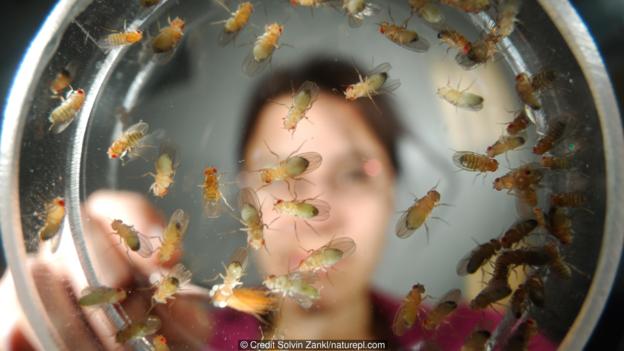
Late Life Plateau
You might think of fruit flies as those annoying gnats in your kitchen, but, in addition to being astronauts, fruit flies might hold important information about predicting death. A study conducted by researchers at the University of California in Irvine (UCI) has found that a decline in fertility in female fruit flies is a reliable indicator that death is close.
The study was initiated as a follow-up to what researchers found in the early 1990s about life not being confined to only two phases—childhood and adulthood. At first it was believed that adulthood starts with us being at our prime and far from the chances of death, and then degradation starts slowly, and then it goes faster and faster leading to death.
However, it was found that at a certain old age, referred to as “late life,” this degradation stops increasing at a steady rate and reaches a plateau. This means that, while a 60-year old person has a higher chance of dying than a 50-year old, a 90-year old person has pretty much the same chances at death as a 100-year old.
“The mortality rates level off and you see these plateaus,” says Dr. Laurence Mueller Ecology & Evolutionary Biology School of Biological Sciences professor at the UCI.
The Less Fertile, the More Likely to Die Soon

Dr. Mueller tried to find out if there were other biological signals of approaching death, despite this unexplained plateau.
“We wondered whether reproduction or female fecundity [fertility] followed the same pattern,” he says. The team observed fertility in female Drosophila fruit flies and found that the less eggs they lay per day, the closer they are to dying.
“We took 2,828 females, and placed each one individually in a vial with two males,” says Mueller. “Every day we moved each female to a new vial and counted how many eggs they had left. And we continued to do this until they had all died.”
What they found was that the number of eggs the flies laid plunged two weeks before they died, and that is regardless of the fly’s age—a significantly younger fly’s fertility rate plummeted the same way as that of a 60-day old fly if they are both about to die. They used this pattern to predict which flies will die each day at 80% accuracy.
The researchers dubbed this as the “death spiral,” and they believe it is a universal feature of life—meaning it also applies to humans, as a succeeding phase to the first three (childhood, adulthood, and late life). Changes in fertility rates as a predictor to human life expectancy has not been definitively proven, however.